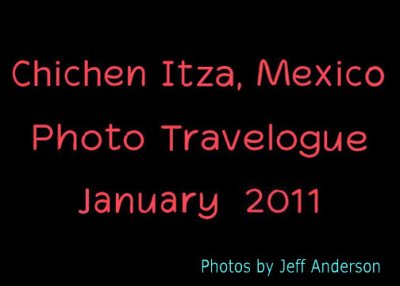
Chichen Itza, Mexico cover page. |

Map of Mexico. |

Map of the Yucatan with Chichen Itza indicated by the blue box. |

Map of Chichen Itza. |

At one of the stops during the tour, we saw this peacock showing off its plumage. |
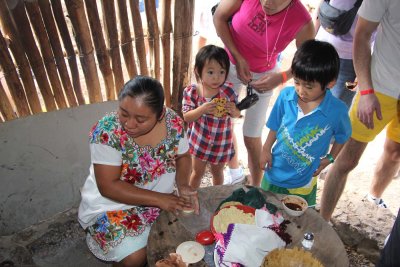
We stopped at this hut where this woman was making Mexican tortillas. |

She is frying them over the fire. |
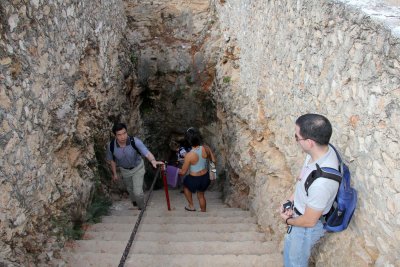
There are numerous sinkholes (cenotes) in the Yucatan including this one called "Ikil," which means "Sacred Blue Cenote." |

Cenote Ikil is almost round. The water is about 90 feet deep. |

A tourist swimming in the sinkhole with other tourists contemplating a swim. I went in but did not stay in the water long. |

You can see a hole in the roof of the sinkhole. |

Cenote Ikil is a big tourist attraction since it is only about 10 minutes from Chichen Itza. |

We stopped at a tourist trap for lunch. These Mayan childbirth statues were for sale. |
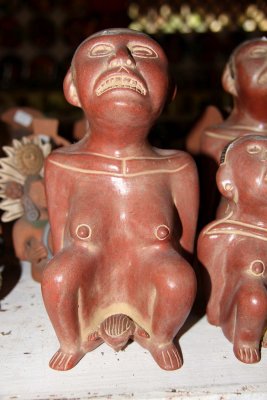
Another Mayan childbirth statue. I did not buy one! |

Perimeter wall of the Great Ball Court in Chichen Itza. The base of the walls are slanted benches for ancient Maya players. |

Outside the Great Ball Court, is the Lower Temple of the Jaguars, where it is still possible to make out colors on the walls. |

View of the ancient Maya pyramid, El Castillo (the Castle), the most famous monument at Chichen Itza. |
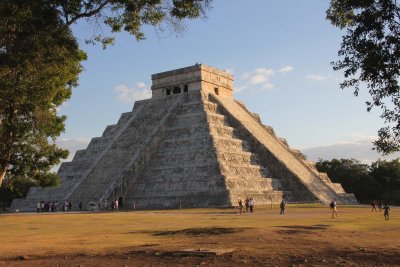
El Castillo has square terraces on the bottom with stairways going up each of the four sides of the temple on top. |

During the Spring and Autumn equinoxes, on the corner of the structure, the sun casts a shadow in the shape of a serpent. |

The serpant is called Kukulcan, or Quetzalcoatl. The shadow is cast along the west side of the north staircase. |

In the mid 1930s, the Mexican government excavated El Castillo and found another temple buried below the current one. |

Inside was a Chac Mool (a stone statue depicting a human figure) and a red Jaguar throne with spots made of inlaid jade. |

Close-up of El Castillo. At one time, the old temple's throne room was opened to the public, but it was the closed in 2006. |

Not every side of El Castillo is restored. This side obviously is not. |

This is a typical Maya hut that we saw at Chichen Itza. |

Inside the hut, the tour guide was explaining about Maya life and culture. |

Along the south wall of the Temple of Warriors are a series of exposed columns called "Group of a Thousand Columns." |

When the city was inhabited these would have supported an extensive roof system. |

The columns are in three distinct sections: an east group, a north group and a northeast group. |

Some of the columns formed a small temple at the southeast corner of the Temple of Warriors. |

Bas-relief carvings of animals near the Temple of Warriors and "Group of a Thousand Columns." |

There are also carvings of people or gods, as well as animals and serpents. |

View of Templo de los Guerreros (Temple of the Warriors) at Chichen Itza. |
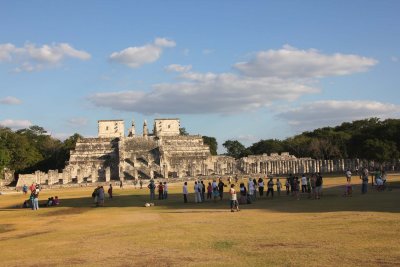
It consists of a large stepped pyramid with rows of carved columns depicting warriors. |

At the top of the stairway on the pyramid’s summit (and leading towards the entrance of the pyramid’s temple) is a Chac Mool. |

View of the Chac-Mool. It is a stone statue of a human figure in a reclining position with the head up and turned to one side. |

This temple encases or entombs a former structure called The Temple of the Chac Mool. |
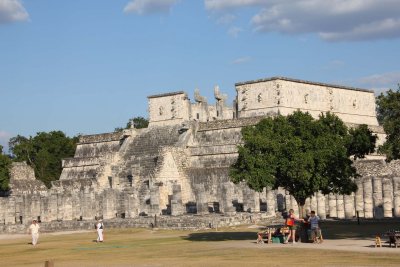
The restoration of this building was done by the Carnegie Institute of Washington from 1925–1928. |

Front view of the Temple of the Warriors. |

Columns of what once was a covered market in Chichen Itza. |

These columns probably held a thatched roof. |

Most guides refer to this area as the marketplace. |

Excavations next to El Castillo began in 2009. |

The new excavations reveal that Chichen Itza is an older city than archeologists realized. |

They found a substructure that predates all three of those structures and is estimated to be from between 8th and 9th centuries. |

The excavation team uncovered 12 linear meters of the substructure, including a building corner, a cornice and a sloped wall. |

According to archaeologist Rafael Cobos, it is not known where it ends or if it has a staircase. |

Platform of Venus in Chichen Itza is dedicated to the planet Venus. |

It is located opposite the pyramid El Castillo, at the entrance to the Ceremonial Fire, the path leading to the Cenote Sagrado. |

It is a low platform which was probably used for public addresses or rituals of some sort, such as dance or sacrifice. |

In its interior archaeologists discovered a collection of large cones carved out of stone, the purpose of which is unknown. |

Maya sculptures of serpent heads protruding from the Platform of Venus. |
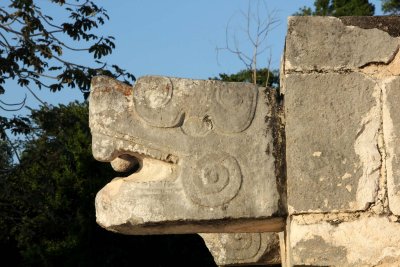
Close-up of one of the serpent heads. |
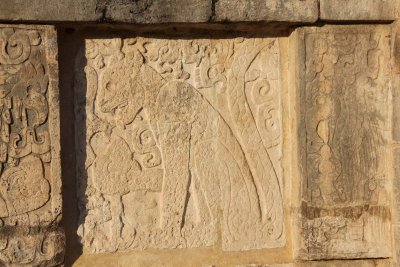
Bas-relief of a jaguar at Chichen Itza. |
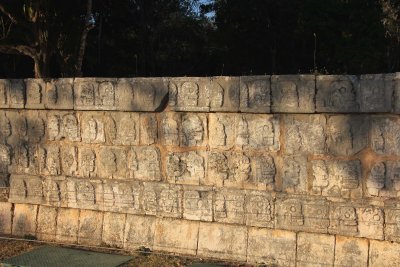
Tzompantli monument is a low, flat platform surrounded with carved depictions of human skulls. |
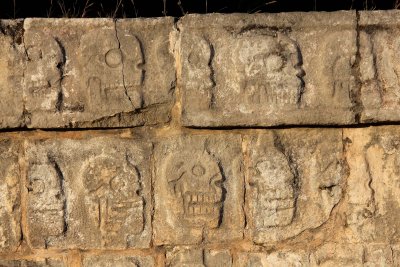
Close-up of the Tzompantli monument. |
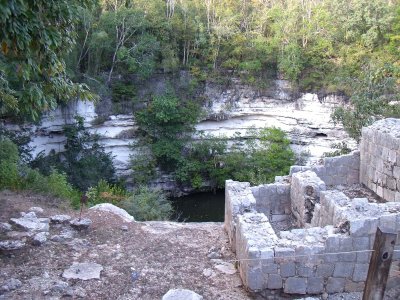
Cenote Sagrado, where Maya sacrificed objects and human beings into this sinkhole to worship to the Maya rain god Chaac. |
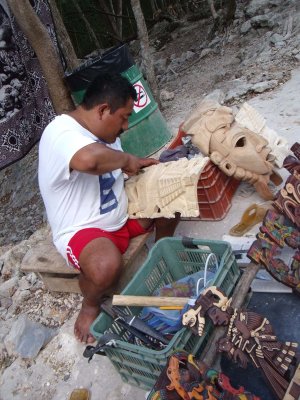
Man carving a Maya mask. |
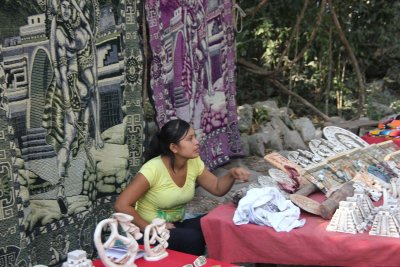
This woman was selling some interesting tapestries |
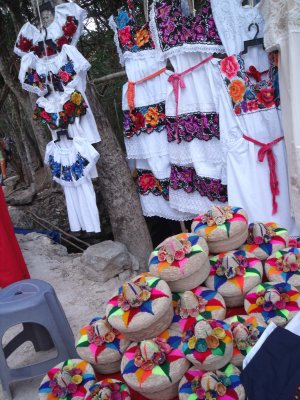
Mexican dresses and baskets for sale. |

These colorful Maya masks were also for sale. |

They came in many shapes and sizes. |











